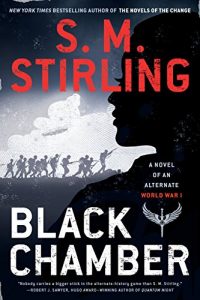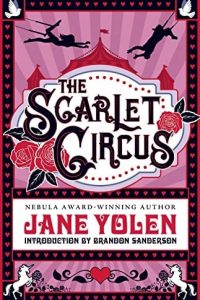Russell Letson reviews Kathleen Ann Goonan
 Kathleen Ann Goonan’s This Shared Dream is a direct sequel to In War Times (reviewed in June 2007), if we understand that in the complex universe(s) of its setting calculating a value for ‘‘direct’’ is a tricky business. The first book took us through WWII and its aftermath, up to the early 1960s, as experienced by engineer/soldier Sam Dance, his friend Wink, and eventually Sam’s wife Bette (OSS, then CIA, and never fully deactivated), and the Dance children. What made the story of Sam, Wink, and Bette more than an ordinary war story (as though such a creature could exist) is what happened when Hungarian polymath Eliani Hadntz got them to activate her Device, which was meant to remake history and somehow create a timeline in which wars and Holocausts could not occur and human nature itself would be transformed.
Kathleen Ann Goonan’s This Shared Dream is a direct sequel to In War Times (reviewed in June 2007), if we understand that in the complex universe(s) of its setting calculating a value for ‘‘direct’’ is a tricky business. The first book took us through WWII and its aftermath, up to the early 1960s, as experienced by engineer/soldier Sam Dance, his friend Wink, and eventually Sam’s wife Bette (OSS, then CIA, and never fully deactivated), and the Dance children. What made the story of Sam, Wink, and Bette more than an ordinary war story (as though such a creature could exist) is what happened when Hungarian polymath Eliani Hadntz got them to activate her Device, which was meant to remake history and somehow create a timeline in which wars and Holocausts could not occur and human nature itself would be transformed.
The new volume is mostly the story of the Dance children and grandchildren and the worlds spun out by the Hadntz Device. The 20th century is full of hinge events: Berlin was taken by the Soviets, or by the Allies; John and Robert Kennedy and Martin Luther King were assassinated, or not; the Cuban Missile Crisis led to nuclear disarmament, or nuclear war. Eliani Hadntz and Bette and Sam Dance and Wink move through and across this complex of histories, while the Dance children do or do not harbor memories of strange pasts and adjust accordingly – or don’t. Multiple viewpoints thread the interwoven (not to say tangled) plotlines, but if there is a central protagonist it is eldest daughter Jill, who knows the most about the multiplicity of histories (since she participated in some of the multiplying). She is also the one most damaged by the stresses of hanging on to a sense of self in a world from which her parents have vanished and which does not always seem to be metaphysically stable.
In a 1991 that is not ours, Jill is 41, married, a mother, a former comix artist, an international banking executive, a bookstore owner, a doctoral candidate, and on the verge of a breakdown and a divorce. When the breakdown does come and lands her in a mental hospital, she is visited by her parents (who have hurried in from a fancy party across the Atlantic in another timestream via an impossible Underground) and then by another mysterious figure. When Jill gets better and moves back into her old family home, Halcyon House, there’s a Walking Man who seems to be watching the neighborhood. There’s a (metaphorical) ‘‘werewolf’’ whose relationship to familial and overarching histories is even more troubled than Jill’s. There are break-ins and stalkings and arson. Eventually, she and we discover who is shadowing her and her siblings, what they’re up to, and the answers to various Mysterious Goings On.
But melodrama and conspiracy are not really at the center of this novel, even if the Goings On are of considerable significance. When they were young, Jill, her brother Brian (who died in the Vietnam War in our timestream but not in this one), and her sister Megan (now an expert on and researcher into the nature of memory) played with a version of the Hadntz Device configured as the Infinite Gameboard – and changed history. Now that Jill has moved back to Halcyon House, the Board resurfaces, as do other manifestations of the Device. But the Dance grandkids – especially fearless, perceptive Stevie (who renames himself Whens) and preternaturally musical Zoe – hardly need direct contact with a Device to express their special natures and talents, and their sections of the book are particularly charming and indicative of where the whole process is heading.
The label ‘‘alternate history’’ does not quite do justice to the book’s plot, let alone its thematics or its science fictional operations. The Hadntz Device, like most time/probability machines, is a black-box enabling device, in this case generating a whole series of second chances for the bloody 20th century. But it is not merely a time-tinkering widget, nor is it the only black-box technology operating in Jill’s 1991. The quantum-computational/communications network called Q fills the niches of cell phone and Internet and not only constitutes an artificial intelligence, but is somehow tied to the Device, and thus the neuroplasticity that sister Megan sees as the way out of humanity’s deeply embedded irrationalities. Combine it with black-box nanotechnology and you have a magician’s hat full of miracles out of which pops Jill’s answer to how to save the world: the self-growing, adaptive, more-than-Montessori pod school. This is the central Idea of the novel, a mechanism designed to foster and preserve the child’s ability to learn and change, to make a world full of Whens and Zoes. If only, Goonan’s characters reason, we could not only provide traditional and Montessorian moral education to children, but somehow trigger in adults the ability to re-form their interior intellectual and emotional environments, we would be free to tackle our problems in a rational manner rather than with the old tools of tribalism and violence. Think of them as the Montessori Schools of Isher.
But the novel is not a tract, nor does time spent with it feel like time spent in a classroom. The characters (especially the children) offer interesting internal environments to wander, and there is a wonderful sense of physical and cultural place: various Washingtons, a Havana unscathed by Cold War conflicts, and especially the aptly named Halcyon House, an embodiment of the Dance-family personality and practically a character itself:
Zoe sat cross-legged on the old floral rug in the Halcyon House living room, a comfortable, sprawling, square room of deep chairs and couches flanked by an eclectic mix of tables and reading lamps, the upright piano, and a fireplace centered on the back wall. The wall was filled with deep, spacious shelves, and opened, on one side, through French doors, onto the house-long screened-in porch.
The house is untidy but rich, crammed with books and music, with an attic full of memories and a set of secret doors and passages that only Sam and Bette know about. I want to live there. The book is generous and hopeful in the face of all the evidence of humankind’s capacity for folly, tribalism, violence, destruction, and general badassery, and I would like to live there, too.







